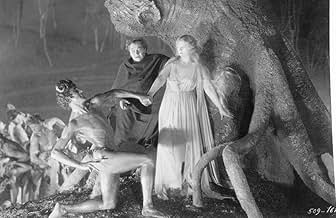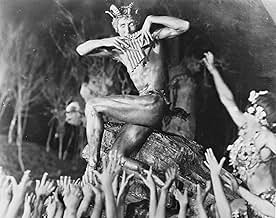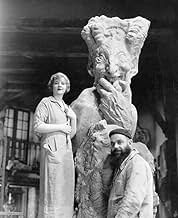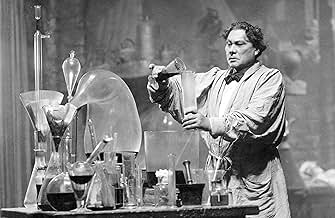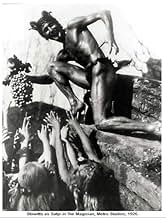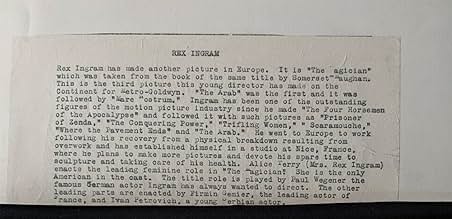Agrega una trama en tu idiomaA magician/alchemist, seeking to create life, finds that he needs the "blood of a virgin" to continue his experiments. He sends out his dwarf assistant to pick out the right girl.A magician/alchemist, seeking to create life, finds that he needs the "blood of a virgin" to continue his experiments. He sends out his dwarf assistant to pick out the right girl.A magician/alchemist, seeking to create life, finds that he needs the "blood of a virgin" to continue his experiments. He sends out his dwarf assistant to pick out the right girl.
- Dirección
- Guionistas
- Elenco
Hubert I. Stowitts
- Dancing Faun
- (as Stowitts)
Claude Fielding
- Dancing Faun
- (sin créditos)
Gerald Fielding
- Dancing Faun
- (sin créditos)
Rosita Garcia
- Arab Girl Bitten by Snake
- (sin créditos)
John George
- Haddo's Dwarf Servant
- (sin créditos)
Michael Powell
- Man with Balloon at Snake Charming
- (sin créditos)
- Dirección
- Guionistas
- Todo el elenco y el equipo
- Producción, taquilla y más en IMDbPro
Opiniones destacadas
Rex Ingram is probably best remembered for directing Rudolph Valentino's breakthrough film THE FOUIR HORSEMEN OF THE APOCALYPSE (1921) but he ventured into the fledgling terror genre with this thriller starring Paul (The Golem) Wegener.
Wegener's character, Dr. Oliver Haddo, is allegedly based on the real life character Alastair Crowley. When we first meet him he is in attendance as the famous Dr. Burdon (Ivan Petrovich) saves the life of lovely Margaret Dauncey (Alice Terry, the real life Mrs. Ingram) with an operation on her spine. While recovering, Margaret falls in love with Dr. Burdon and he returns her affections. Dr. Haddo is interested in her too but for far less healthy reasons. Dr. H you see, has been searching for the way to create artificial life in the laboratory (sound familiar?) and a old book on alchemy has informed him that he needs "the heart blood of a maiden" added to certain other chemicals to make this happen.
So determined is Haddo to make this happen that he hypnotises Margaret and marries her while she is under his spell. At his mountain top lab he plans to complete his diabolical experiment. Will Margaret lose her own life so Haddo can create life? Will Dr. Burdon find her in time? Ah . . . that would be telling!
What many of us wonder is, is Haddo a real magician or just a very good hypnotist? In one scene he allows a poisonous snake to bite him but makes the lethal wound vanish with just a wave of his hand. Just a moment later the same snake bites a young woman and she must be rushed to hospital. Now most of us know that a venomous snake expels all its venom at the first bite so the fact that it was the second bite that felled the woman should have been a tipoff that Haddo was not bitten at all. Yes, but remember this is a movie and we have to build up suspense. An amusing scene has Dr. Burdon and Dr. Haddo meeting for the first time in a park. As Haddo walks away Burdon remarks to Margaret "He looks like he stepped out of a melodrama!". As if on cue Haddo glares back, throws his cape over his shoulder and makes a perfect stage exit! It is an innocuous but effective moment and briefly clouds the menace that will soon be facing the lovers.
The sequence most people remember is where Haddo gives Margaret a look at Hell. It is a rugged looking place but rather removed from the horrors of the Italian film L'INFERNO (1909) or even DANTE'S INFERNO (1926). The place is loaded with damned souls but they all dance around carefree while Pan (at least I think it's Pan) plays a tune on his pipes. Another faun (dancer Hubert Stowitts) takes Margaret in his arms and passionately kisses her as the dream ends. So did they really go to Hell or was it all a hypnotic dream? In a key scene soon after this Haddo visits Margaret at her home and we clearly see his lips say the words "your rape" which sends her into the deepest despair. Whether the rape was actual or just implied quickly becomes a moot point because she goes away with him, convinced she can never marry Dr. Burdon now.
Elements of the final reels of THE MAGICIAN figure prominently in the Universal film FRANKENSTEIN (1931). Haddo has a monolithic castle at the top of a mountain, a dwarf assistant do you think his name is Fritz?) and a well equipped lab. I think that not only director James Whale but also the set designer for FRANKENSTEIN had to have sat through this film more than once.
Talkies came along about a year after this film was completed and Wegener, who was uncertain of his ability to speak English, returned to Germany. He was not alone, he was soon joined by Emil Jannings, Conrad Veidt and several other actors who had their doubts about being able to effectively perform in a foreign (to them)language.
So is THE MAGICIAN worth seeing? Yes it is, despite its shortcomings it is a well paced and convincingly performed thriller. Give it a try.
Wegener's character, Dr. Oliver Haddo, is allegedly based on the real life character Alastair Crowley. When we first meet him he is in attendance as the famous Dr. Burdon (Ivan Petrovich) saves the life of lovely Margaret Dauncey (Alice Terry, the real life Mrs. Ingram) with an operation on her spine. While recovering, Margaret falls in love with Dr. Burdon and he returns her affections. Dr. Haddo is interested in her too but for far less healthy reasons. Dr. H you see, has been searching for the way to create artificial life in the laboratory (sound familiar?) and a old book on alchemy has informed him that he needs "the heart blood of a maiden" added to certain other chemicals to make this happen.
So determined is Haddo to make this happen that he hypnotises Margaret and marries her while she is under his spell. At his mountain top lab he plans to complete his diabolical experiment. Will Margaret lose her own life so Haddo can create life? Will Dr. Burdon find her in time? Ah . . . that would be telling!
What many of us wonder is, is Haddo a real magician or just a very good hypnotist? In one scene he allows a poisonous snake to bite him but makes the lethal wound vanish with just a wave of his hand. Just a moment later the same snake bites a young woman and she must be rushed to hospital. Now most of us know that a venomous snake expels all its venom at the first bite so the fact that it was the second bite that felled the woman should have been a tipoff that Haddo was not bitten at all. Yes, but remember this is a movie and we have to build up suspense. An amusing scene has Dr. Burdon and Dr. Haddo meeting for the first time in a park. As Haddo walks away Burdon remarks to Margaret "He looks like he stepped out of a melodrama!". As if on cue Haddo glares back, throws his cape over his shoulder and makes a perfect stage exit! It is an innocuous but effective moment and briefly clouds the menace that will soon be facing the lovers.
The sequence most people remember is where Haddo gives Margaret a look at Hell. It is a rugged looking place but rather removed from the horrors of the Italian film L'INFERNO (1909) or even DANTE'S INFERNO (1926). The place is loaded with damned souls but they all dance around carefree while Pan (at least I think it's Pan) plays a tune on his pipes. Another faun (dancer Hubert Stowitts) takes Margaret in his arms and passionately kisses her as the dream ends. So did they really go to Hell or was it all a hypnotic dream? In a key scene soon after this Haddo visits Margaret at her home and we clearly see his lips say the words "your rape" which sends her into the deepest despair. Whether the rape was actual or just implied quickly becomes a moot point because she goes away with him, convinced she can never marry Dr. Burdon now.
Elements of the final reels of THE MAGICIAN figure prominently in the Universal film FRANKENSTEIN (1931). Haddo has a monolithic castle at the top of a mountain, a dwarf assistant do you think his name is Fritz?) and a well equipped lab. I think that not only director James Whale but also the set designer for FRANKENSTEIN had to have sat through this film more than once.
Talkies came along about a year after this film was completed and Wegener, who was uncertain of his ability to speak English, returned to Germany. He was not alone, he was soon joined by Emil Jannings, Conrad Veidt and several other actors who had their doubts about being able to effectively perform in a foreign (to them)language.
So is THE MAGICIAN worth seeing? Yes it is, despite its shortcomings it is a well paced and convincingly performed thriller. Give it a try.
First time on TCM,so I was curious to see this old "svengali" type film.The name alone was intriguing "The Magician".What I found was a totally intact silent of the best quality.The Villain in the picture plays it to the hilt,in somewhat cartooned expressions,but always creepy and interesting.The backdrop of Paris is of interest as are the colour sequences.The clothing in this film are especially attractive as is the well groomed cast.I was captivated from start to finish,what a treat to see a silent as it should be.The acting was wonderful from all,even though I had never heard of these particular actors before.I am a lover of old horror films and this really fit the bill.Enjoyed the castle,and early special effects.
In the 1920s films dealing with supernatural evil were extremely rare. However, director Rex Ingram, obviously influenced by earlier German forays into the supernatural, cast German actor Paul Wegener of DER GOLEM in this adaptation of Somerset Maugham's novel THE MAGICIAN. Wegener's menacing performance as an evil Yogi in LEBENDE BUDDHAS (1925) made him a good choice to play Oliver Haddo, obsessed with creating life from an ancient formula requiring the heart's blood of a maiden, played by Ingram's wife Alice Terry.
John F. Seitz' cinematography is superb, especially in the depiction of the heroine's hallucinatory descent into Hell where she is figuratively ravished by a lustful and athletic satyr. And although Haddo doesn't succeed in creating the grisly, half-complete humans as in the novel, the controversial subject matter was nevertheless strong enough to insure the film's failure at the box-office in 1926.
Interesting comparisons have been made between this film and James Wale's FRANKENSTEIN, but the subject of black magic also invites comparison with later films - THE BLACK CAT (1934), THE NIGHT OF THE DEMON (1957), and THE DEVIL RIDES OUT (1968) - featuring characters who like Oliver Haddo were modeled on real-life occultist Aleister Crowley.
John F. Seitz' cinematography is superb, especially in the depiction of the heroine's hallucinatory descent into Hell where she is figuratively ravished by a lustful and athletic satyr. And although Haddo doesn't succeed in creating the grisly, half-complete humans as in the novel, the controversial subject matter was nevertheless strong enough to insure the film's failure at the box-office in 1926.
Interesting comparisons have been made between this film and James Wale's FRANKENSTEIN, but the subject of black magic also invites comparison with later films - THE BLACK CAT (1934), THE NIGHT OF THE DEMON (1957), and THE DEVIL RIDES OUT (1968) - featuring characters who like Oliver Haddo were modeled on real-life occultist Aleister Crowley.
Its all here in embryo: the paradigm for Frankenstein. The mad scientist, trying to create life in his laboratory located in a forbidden tower on the top of a rocky mountain, while thunder and lightning terrify the superstitious villagers. Supposedly adapted from a W. Somerset Maugham novel, the possibility exists that it was Maugham (a qualified physician) who, still very much on the make for an overwhelming success in his third book, might have cribbed more than a little bit from Mary Shelly. However, instead of the Romantic Prometheus, driven mad by hubris and symbolic of mankind's desire to harness newfangled science to dominate and conquer nature, despite the warnings of terrible consequences, all taking place on the edge of the Industrial revolution, we have the elements shaped into a Victorian melodrama of the villain-continued-to-pursue-her variety complete with virgin's blood and a heroine tied in artful knots, and a villain motivated by nothing more than criminal insanity.
On the other hand the artful visual qualities of the storytelling is something that has been lost in today's film vocabulary. A zippy 80 minutes or so, today the coarse need for thrills from this type of film would have necessitated a number anatomically gruesome murders before the final heroine jeopardy and heroic rescue. Here a little horror goes a very long way (all the way to the French Riviera, in fact). THE MAGICIAN is everything that made the silent film, at the same time, so great and so very silly. By the way, shots of Paris, virtually traffic free are a revelation, as are shots of a cobblestone village high up in the mountains (the Alps Maritimes) behind the Riviera. And yes, that's the same Paul Wegener who directed and starred in two versions of The Golom as well as playing Svengali in a 1927 version of the Du Maurier story.
On the other hand the artful visual qualities of the storytelling is something that has been lost in today's film vocabulary. A zippy 80 minutes or so, today the coarse need for thrills from this type of film would have necessitated a number anatomically gruesome murders before the final heroine jeopardy and heroic rescue. Here a little horror goes a very long way (all the way to the French Riviera, in fact). THE MAGICIAN is everything that made the silent film, at the same time, so great and so very silly. By the way, shots of Paris, virtually traffic free are a revelation, as are shots of a cobblestone village high up in the mountains (the Alps Maritimes) behind the Riviera. And yes, that's the same Paul Wegener who directed and starred in two versions of The Golom as well as playing Svengali in a 1927 version of the Du Maurier story.
I read Carlos Clarens "Horror Movies" in '68 and it was one of the bigger influences on my movie tastes (as was seeing my first movie "House on Haunted Hill" in the theater with Emergo when I was five years old) so I'm inclined to recommend this movie for those who would like a fluid distillation of what was best about the silent cinema.
I saw it at the Film Forum in NYC around '92 or '93. Ingram had moved to France and The Magician is notable for its documentary footage of Paris, Monaco and the French countryside. Wegener is a formidably grotesque presence and there is a remarkable set piece at the very beginning when a huge clay sculpture collapses, seeming at first to come to life, sending Alice Terry to the hospital. Oliver Haddo, the magician of the title, lurks in the observation gallery as a life saving operation is performed on her...
This movie really has it all so don't miss it if you get the chance especially if you can see it with live musical accompaniment.
I saw it at the Film Forum in NYC around '92 or '93. Ingram had moved to France and The Magician is notable for its documentary footage of Paris, Monaco and the French countryside. Wegener is a formidably grotesque presence and there is a remarkable set piece at the very beginning when a huge clay sculpture collapses, seeming at first to come to life, sending Alice Terry to the hospital. Oliver Haddo, the magician of the title, lurks in the observation gallery as a life saving operation is performed on her...
This movie really has it all so don't miss it if you get the chance especially if you can see it with live musical accompaniment.
¿Sabías que…?
- TriviaThis movie, especially the explosion of the laboratory, influenced James Whale while making the Frankenstein (1931) movies.
- Citas
Dr. Arthur Burdon: Your niece is certainly the most beautiful patient I have ever had.
Selecciones populares
Inicia sesión para calificar y agrega a la lista de videos para obtener recomendaciones personalizadas
Detalles
- Tiempo de ejecución1 hora 23 minutos
- Mezcla de sonido
- Relación de aspecto
- 1.33 : 1
Contribuir a esta página
Sugiere una edición o agrega el contenido que falta

Principales brechas de datos
By what name was El Mago (1926) officially released in India in English?
Responda
